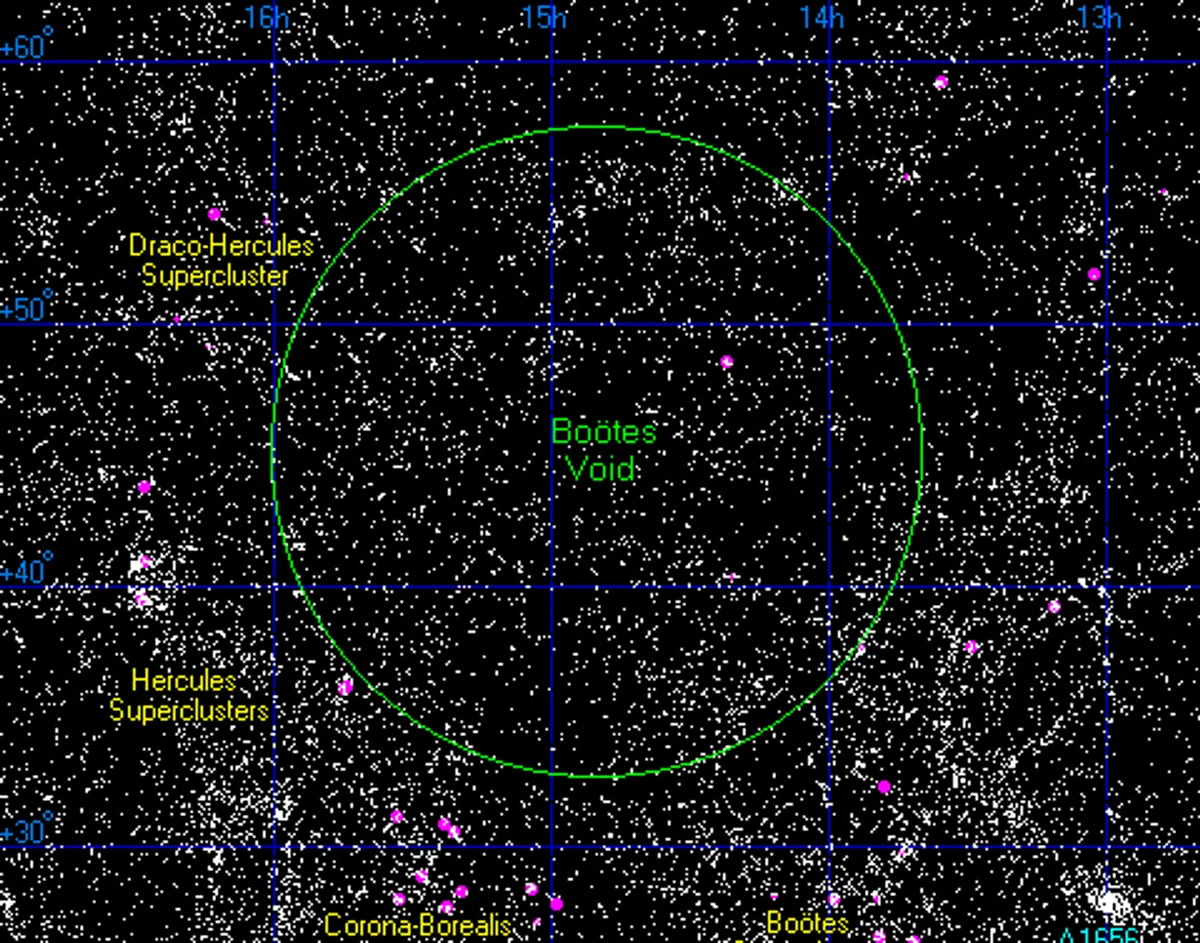In 1981, while conducting a redshift survey of the distribution of galaxies, astronomers spotted something (or nothing) that they weren’t expecting.
“[W]e discovered that the redshift distributions in each of the three northern fields showed an identical 6,000 [kilometers per second] gap. Because these fields were separated by angles of ~35°, this suggested the existence of a large void in the galaxy distribution of at least comparable angular diameter,” the team wrote in a paper in 1987, adding, “The low density of this region is of high statistical significance and does not appear easily reconcilable with any of the popular models for the growth structure in the universe.”
Lying in the vicinity of the Boötes constellation, it became known as the Boötes Void, or sometimes the Great Nothing. For a long time, it was the largest known void in the universe, spanning 330 million light-years across. To put that in context, that’s about 0.35 percent of the diameter of the entire observable universe.

A big span of nothing.
While it is fair to describe it as a void, there are galaxies within it, just a lot fewer than we would expect.
“If we are to use a rough estimate of about one galaxy every 10 million light-years (four times farther than Andromeda),” NASA explains, “there should be approximately 2,000 galaxies in the Boötes Void.”
In fact, we’ve found 60. While there is little about the void to suggest our ideas about galaxy formation are incorrect – one explanation is that it formed from smaller voids merging – it is still an odd thought experiment to picture how someone inside the void must see the universe.
As astronomer Greg Aldering put it: “If the Milky Way had been in the center of the Boötes void, we wouldn’t have known there were other galaxies until the 1960s.”
That was the largest void that we know of. But in 2015, a team found evidence of a much larger void, measuring a whopping 1.8 billion light-years across. The team were looking in the direction of the infamous cold spot of the cosmic microwave background radiation, believing that the cold spot could correspond to a massive void.
Sure enough, they found evidence of a void spanning 1.91 percent of the diameter of observable universe, although the void is still not large enough to explain the mysterious cosmic microwave background (CMB) cold spot. The KBC Void, with a radius of around 1 billion light-years, is notable for containing our home galaxy, the Milky Way.
Like the Boötes, the KBC Void (or Local Hole) is not a true void, but an area of underdensity, with measurements varying from around 15-50 percent less dense than the surrounding regions. Merely counting the number of galaxies supports the idea of a local void, as there are fewer galaxies in our local region than in the neighboring regions.
There are quite a few reasons why this may be interesting. For one, our models predict that matter should be distributed fairly evenly through the universe at large scales, and this is at odds with those predictions. But where it gets really interesting is when looking at the expansion of the universe, and the “Hubble tension”.
The Hubble tension, for the uninitiated, refers to the fact that measurements of the expansion of the universe differ depending on how you measure it. Looking at the CMB radiation – the first light of the universe from around 400,000 years after the Big Bang – puts the rate of expansion at 67.4 kilometers per second per megaparsec, with 1 megaparsec being 3.26 million light-years. Meanwhile, measurements of how fast objects move away from each other in the local universe – focusing on “standard candles” like type 1a supernovae and Cepheid variables – puts the expansion rate at 73 kilometers per second per megaparsec.
“A potential solution to this inconsistency is that our galaxy is close to the centre of a large, local void,” Dr Indranil Banik, of the University of Portsmouth, explained in a statement following one study on the local void.
“It would cause matter to be pulled by gravity towards the higher density exterior of the void, leading to the void becoming emptier with time.
“As the void is emptying out, the velocity of objects away from us would be larger than if the void were not there. This therefore gives the appearance of a faster local expansion rate.”
For this idea to work, the Milky Way would need to be near the center of the void, which would have to be around 20 percent under-dense compared to the universe’s average.
“The Hubble tension is largely a local phenomenon, with little evidence that the expansion rate disagrees with expectations in the standard cosmology further back in time,” Banik added. “So a local solution like a local void is a promising way to go about solving the problem.”
More study is needed to determine exactly how under-dense the local region is, and whether it could be the explanation for the Hubble tension. That might be quite a relief, given the tension’s stubborn persistence, but with it new mysteries may follow, and we could have to abandon the idea that at large scales, the universe looks roughly the same, and get comfortable living in a gigantic void.
Source Link: We Might Be Living Inside A 2 Billion Light-Year Void, And It Could Help Clear Up One Of The Biggest Mysteries In Cosmology